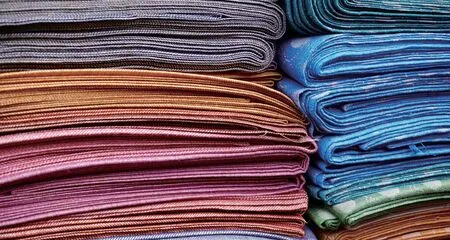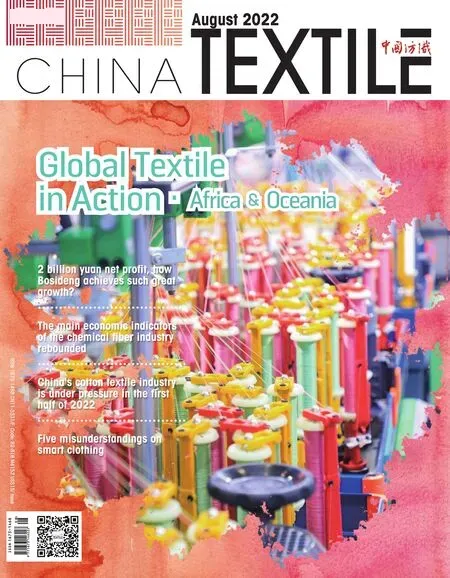China's cotton textile industry is under pressure in the f irst half of 2022
Edited by Zhong Mengxia

Since the beginning of this year, a new round of pandemic has been repeated, the situation in Russia and Ukraine has escalated, the prices of commodities have fluctuated drasti—cally, and inflation has been high. World economic growth is facing multiple risks. In the past two months, the domestic macro—economy has been running smoothly, driven by the ef—fect of steady growth policy. From March to April, the domestic pandemic continued to spread, the industrial chain and supply chain were not running smoothly, and the consumer demand in the textile market was low. Since May, with the overall improve—ment of pandemic prevention and control situation in China,the effects of various steady growth policies have gradually appeared, enterprises have resumed work and production in an orderly manner, and their income and exports have maintained a year—on—year growth trend, which shows the strong develop—ment resilience and risk resistance of the cotton textile industry.
Production development
According to the tracking data of China Cotton Textile Industry Association, in the first half of this year, the utiliza—tion rate of textile equipment of tracking enterprises dropped sharply compared with last year. Generally speaking, the equipment utilization rate of cluster enterprises, which are mainly small and medium—sized enterprises, is kept at about 70%, and that of key enterprises is better than that of cluster enterprises, among which the utilization rate of spinning equip—ment is higher than that of weaving. The yarn output of key enterprises decreased by 2.4% year—on—year, and the fabric output was relatively better than the yarn output year—on—year,which was related to the fact that the fabric production base was lower than the yarn output in the same period last year.Th e cumulative output of yarn and fabric in cluster decreased by 2.9% and 2.4% respectively. The market continued to be deserted, the downstream orders decreased, the market had a strong wait—and—see mood, and the sales volume of yarn and cloth shrank, with a cumulative year—on—year decline of 4.9%and 1.2% respectively. Th e stock of yarn and cloth is increasing,and the stock level of most enterprises is at a high level, while the stock of yarn and cloth in some enterprises is more than two months.
The price of raw materials fluctuates greatly
Since the beginning of this year, as of mid—June, the domestic standard cotton price has been fluctuating at a high level in the range of 20,000—23,000 yuan/ton (the highest level in recent ten years). In late June, as the market became more worried about the economic recession in the United States, the prices of U.S. stocks and commodities fell sharply in the sell—off, and the international cotton price plunged continuously.The related problems in Xinjiang and the sluggish downstream consump—tion led to the domestic cotton price entering the downward channel. The price dropped to 180,000 on June 30th. The price difference between domestic and foreign cotton fluctuates violently. Since March, interna—tional commodity prices have risen rapidly and international cotton prices have strengthened. Since the end of March, international cotton prices has exceeded the domestic cotton prices, and the price difference between domestic and foreign cotton is upside down, with the highest value ex—ceeding 6,700 yuan/ton.
The prices of viscose staple fiber and polyester staple fiber rose sharply.Supported by rising production costs and better pre—sales, the price of vis—cose staple fiber increased, and the price of viscose staple fiber increased by 25.1% at the end of June compared with the beginning of the year; Polyester staple fiber increased by 20.8% over the beginning of the year. However, in the first half of this year, the average price difference between cotton, viscose staple fiber and polyester staple fiber was at an all—time high. From January to June, the average price difference reached 8,137 yuan/ton and 13,938 yuan/ton. At the same time, from the perspective of yarn sales, the sales of pure chemical fiber yarn and blended yarn are generally better than those of pure cotton yarn, which superimposed the related problems in Xinjiang. Enterprises gradually adjust the product structure, increase the use of non—cotton fibers and produce differentiated products.
Revenue and exports continued to grow
Facing the fluctuation of raw material prices, weak demand and high inventory, the economic benefits of cotton textile enterprises continue to be under pressure. In the first half of this year, the ac—cumulated operating income of key enterprises increased by 5.7%year—on—year, and the growth rate dropped by 0.6 percentage points from January to May; Export delivery value grew by 6.9% year—on—year, down 2.3 percentage points from January to May; Total profit decreased by 19.0% year—on—year, which was 4.1 percentage points higher than that in January—May; The loss was 32.5%, an increase of 3.5 percentage points from January to May and a year—on—year in—crease of 15.0 percentage points.
The prosperity index continues to be below the prosper—ity line. In June, the cotton textile prosperity index was 46.57,down 2.07 from May. According to the classification index, the seven indexes (raw material purchase, raw material inventory,output, product sales, product inventory, business operation and business confidence) that make up the prosperity index of China's cotton textile industry are all below the prosperity line, and they are further lower than those in May, indicating that the industry is in a poor condition.
The domestic market is expected to rebound
In the first half of the year, faced with the compli—cated environmental changes at home and abroad, the cotton textile industry actively responded by increasing the application of non—cotton fibers, improving the con—tinuous, automatic and intelligent level of production,practicing internal strength, overcoming various difficul—ties that affect the production and operation of enter—prises, and moving on under pressure. Looking to the future, in the second half of the year, in June 2022, the World Bank lowered its global economic growth forecast for 2022 to 2.9%. The international environment is still severe and complicated. Due to the unexpected change in global inflation, the delay of geopolitical crisis and the tightening of monetary policy by the Federal Reserve,the global economic growth rate has declined. But since June, China's economic resilience has been highlighted and more positive factors have emerged. With the implementation of a package of steady growth policies such as finance, currency, industrial chain supply chain,etc., China's economy is expected to give full play to its advantages of good resilience, great potential and wide space in the second half of the year, with the growth rate picking up quarter by quarter and the domestic market demand expected to increase. Meanwhile, RCEP will fur—ther strengthen the trade cooperation between China's cotton textile industry, ASEAN, Japan and South Korea."Golden September and Silver October" is coming soon,expecting a turnaround in the market.

